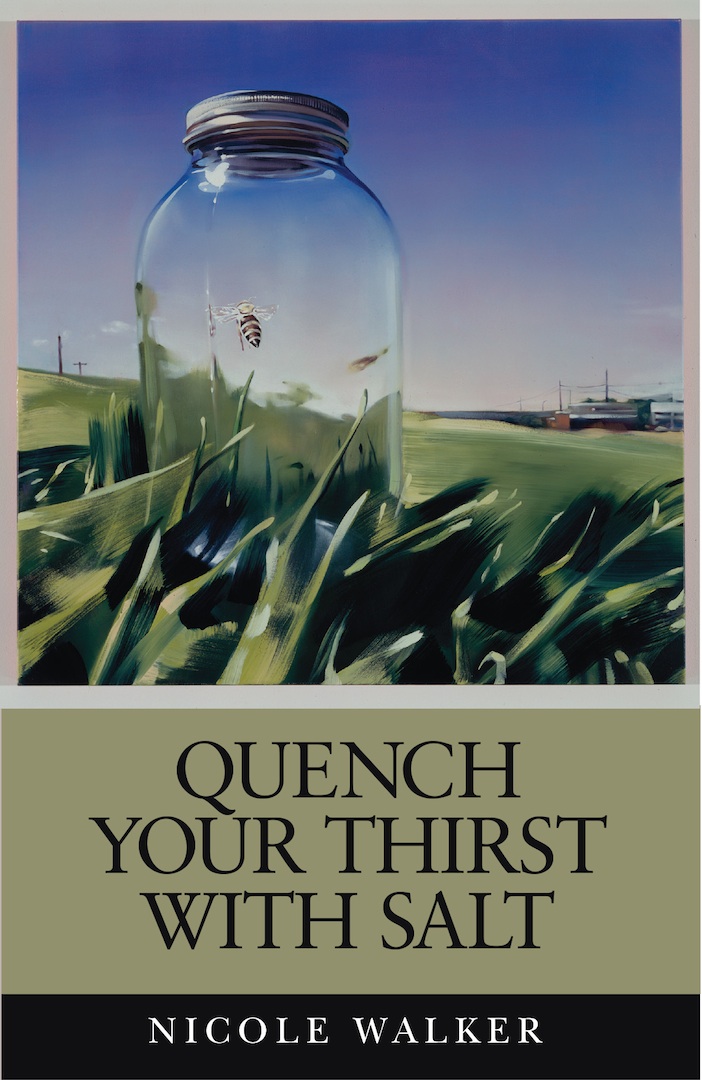Nicole Walker’s Quench Your Thirst With Salt puts us on alert with its koan of a title, that counterintuitive command. From the start, we have an inkling that Walker will turn some of our expectations inside out like an errant sleeve.
This collection is a kaleidoscope, creating with each turn a new design from colors and patterns of everyday things, like water and rock, that we’ve seen before. “Carbon plus oxygen turns cigarettes to smoke, gasoline to air, men into metaphors,” claims Walker. “A sea of cars during rush hour is propelled by pressed plankton never seen by human eyes. Only the polar bears seem to notice the heat from tailpipes rising along with the skybound plants.”
There’s plenty of thirst in the book, from a father’s alcoholism to a study of irrigation, the dams and pipes and sprinklers required to upholster the dry land of Utah, a place where “the green always seems misplaced.”
But in Quench Your Thirst, Walker tells us not so much what to drink but how to see, so that we can discern what’s water and what’s land. As anyone who’s driven through the desert can attest, it’s not always easy to tell the difference. Walker shows unexpected similarities in the everyday. Take, for example, a cooking lesson in the essay “Fish”: “Make the reduction open up and hook elbows with a molecule of the fat. Water and oil don’t mix, my ass. Water and oil are the same thing, if you whisk fast enough.”
We think we know what a feather is, or a diamond. But as Walker draws us closer to those shapes in her vivid prose, those shapes shed their former familiarity. As Walker explains, “In essence, a diamond is one large molecule. And yet, what can you really know about elemental essence? Is the carbon in a piece of black coal still coal inside the diamond? Is a fiddlehead’s frond, crushed by millennia, a water diamond or a molecule of thick water, still a frond?”
Such moments are characteristic of Walker’s persona in this collection. Often she begins an essay with a provocative question, as she does in “Thistle Landslide”: “What has the power to reshape? Outside sources usually—backhoes and Big Macs, concrete and liposuction, but what can change topography from the inside?" Walker exhibits a ranging curiosity, a willingness to follow a subject to its source with an explorer’s pick and pluck. Where does it go, Walker asks, of the toilet paper, the “golf balls, engine oil, Wendy’s wrappers” in the street? Where does it go, the grief of a lost parent or lost innocence?
Experiences leave their traces, not unlike the shells of a long gone lake, or a landscape marked by “bathtub rings of the once-inland sea.” It’s the essayist’s as well as the geologist’s job to record these marks, to decipher the stories they hold. Geology is full of great metaphors, and certainly a field with which you must reckon if you live in Utah, the backdrop for many of these essays. Walker questions the reliability of rock. Rocks don’t rest. The earth breathes. This instability affects form, too. In several essays, the sedimentary layers of ideas build and then artfully buckle, leaving the reader to do some quick thinking, to realize we’ve been holding our breath.
Danger is never far off in this book. These essays register the threat of flood, drought, and earthquake, dramatic, Old Testament scenarios. Rocks shift. Boundaries give way. An unknown boy sneaks into an aviary to molest a flamingo. A young man from church frames his sexual advances in the language of the LDS priesthood. A father falls from a ladder. He falls off the wagon. A family ruptures. The characters explored here are like rock, strong yet fragile, and under great pressure.
Walker expertly allows the personal to expand outward, such as when she embeds news stories in the essays. (One minor disappointment is that these extra-textual elements could be an occasion for more interesting and adventurous formatting.) Walker writes about environmental dangers without tilting into screed. She lays bare the ignorance of an earlier self : “No one had even suggested that the invisible stuff we were pumping out the back of the exhaust pipe was layering itself against the atmosphere, glazing the sky in sheets of glass that could build so thick and reflect back only so much light and grow so heavy, that all that glass might shatter, raining in hot sluices all that pressed forest back down upon our heads.” Walker admits “we were convinced only by what we could see.” Walker has particular impatience for the lawn-waterers of the desert West. But she also reckons with her own climate impact. These essays prompt in the reader a similar kind of self-awareness, a recognition of our individual complicity in some of these global changes.
Walker reminds us what the elements of essays—their rock, water, and air—can build. It’s a strength not of a fortress but of a skeleton. The fragmentation and juxtaposition, the open-endedness, leave spaces; it’s an airiness, a leanness and meanness, Walker uses as a strength.
It’s a book driven by thirst, the quest that pulls us forward. A thirst for justice, for an apology, for a wising-up, for preservation of resources, for a world safe and fair for a young daughter. For all its bleak news, the book is hopeful, exuberant, even while the thirst, Walker affirms, is endless, its quenching a momentary stay.
